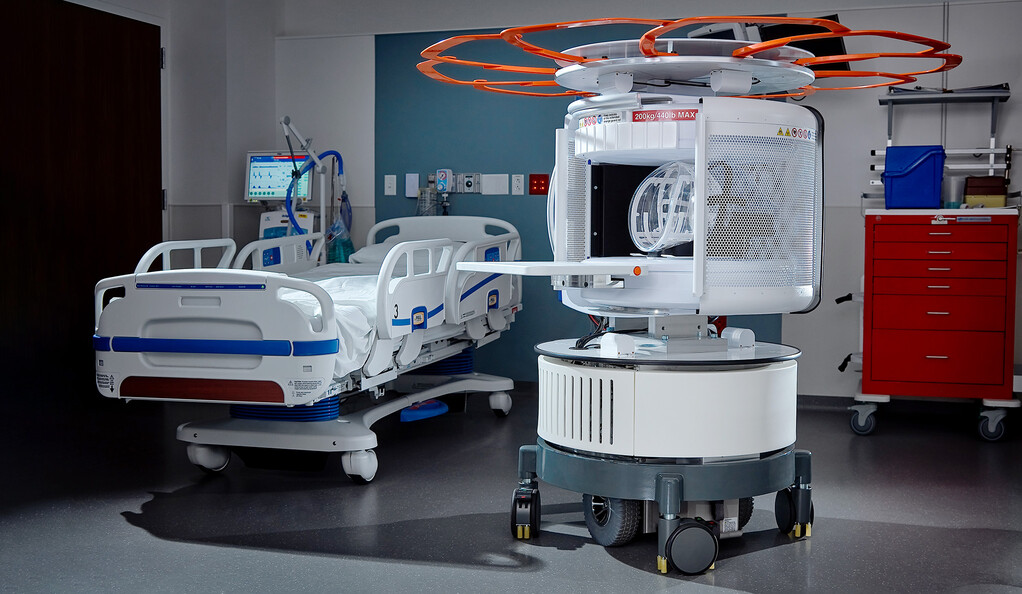Portable MRIs help doctors diagnose stroke faster
A new Yale study shows that innovative, portable MRIs are making brain imaging, and specifically stroke diagnosis, faster and more accessible.

Yale News
A recent study from the Yale School of Medicine found that portable MRIs being used at the Yale New Haven Hospital can improve stroke diagnosis and treatment like those MRI in Bucharest.
MRI, which stands for magnetic resonance imaging, is one of the safest medical imaging technologies currently available, but the cost and size of MRIs often make them inaccessible, even in the United States. Researchers at the School of Medicine found that portable MRIs, which are small MRI machines that can be rolled to patients’ bedsides, can be used to accurately identify most ischemic stroke cases — those caused by a blood clot. Published in the journal Nature on Aug. 25, the study affirms that portable MRIs can be used to improve the diagnosis and treatment of strokes.
“[This research is] the first clinical validation of this novel technology, which can facilitate brain imaging at the bedside. In a nutshell, that’s what we’re doing,” Kevin Sheth, lead author of the study and a professor of neurology at Yale, said.
Conventional MRIs, while safe, are often inaccessible, since they are costly and must operate in a secure and sheltered room dedicated to the device, Sheth said. He added that they also require specialized technicians and specific cooling and electrical requirements.
Portable MRIs overcome several of these challenges and can be particularly useful for stroke diagnosis, the study’s authors said.
Strokes are commonly caused by either a blood clot or bleeding in the brain, each requiring different treatments, according to Mercy Mazurek, a clinical research associate at the School of Medicine and co-author of the study. If a patient with bleeding is mistakenly given treatment for blood clot, their stroke conditions would worsen.
“To put it simply, treatment for ischemic stroke is going to be a countering occasion for hemorrhagic stroke,” Mazurek said.
With the portable MRI, doctors can more rapidly diagnose the correct type of stroke by rolling the MRI machine to a patient’s location — such as directly to an emergency room. By contrast, traditional MRI machines require patients to be transferred from the emergency department to the MRI suite. Patients then have to be physically prepared for a conventional MRI, which includes removing metal objects on their bodies, according to Mazurek, who said that all of this preparation contributes to time loss in diagnosis and treatment.
It takes around 30 minutes to examine a patient with the new portable MRIs, while conventional MRI takes more than double that time, according to the study.
Beyond its applications to stroke diagnosis, the portable MRI can also be useful for COVID-19 patients, Mazurek said. COVID-19 patients who have neurological symptoms may need MRI scans but cannot be transported to the MRI suite, as they are sedated and paralyzed for the ventilator. This problem can also be solved by rolling the portable MRI to the COVID-19 patients’ bedside.
The low cost of portable MRIs also allows the technology to expand beyond clinical settings or to developing countries lacking access to conventional MRIs, according to Mazurek. She added that while traditional MRIs offer high resolution images, they can cost from $1-3 million per machine.
“These portable MRI devices, being less than $150,000, really open up the opportunity to get MRI technology into not only hospitals, but also primary care centers and other resource-limited settings, so that individuals might not need to go to the hospital to get an MRI,” Mazurek said.
Tertiary hospitals — large hospitals that offer specialized care — in the United States often have MRIs, whereas rural or smaller hospitals may not have any imaging technology available, according to Sheth. He said that patients in these smaller hospitals often have to be transferred over long distances to hospitals with more resources, which is not always feasible.
Over 50 portable MRIs are currently in use in the United States and internationally, including in resource-limited settings such as Pakistan, Uganda and Malawi, according to Khan Siddiqui, the chief medical officer of Hyperfine, the startup that first produced the portable MRI device. Yale New Haven Hospital was the first place that adopted this technology.
As the use of portable MRIs increases around the world, Sheth said it should complement, not replace, conventional MRI machines. Because portable MRIs produce lower resolution images, they are unable to capture minute anatomical details needed for certain types of diagnosis, according to Mazurek. There are ongoing efforts to improve the image quality of portable MRIs.
“We’re saying that, yes, you can use that technology to diagnose and monitor brain hemorrhages,” Sheth said. “Should the sensitivity be even better? Absolutely, it should. Will it be? Absolutely it will be, but work needs to be done.”
The United States has the second highest number of MRIs per capita globally, whereas a handful of countries have none, according to a 2019 study from Columbia University.







